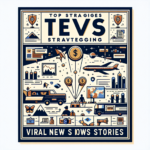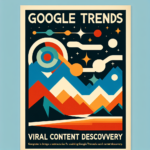Introduction to Content Distribution Strategy
Are you struggling to get your content seen by your desired audience? Frustrated that your well-crafted messages aren’t getting through? You’re not alone. In a world overflowing with information, it’s important to have a robust and effective content distribution strategy.
In this article, we will provide a comprehensive guide on how to craft a strategic and successful content distribution roadmap. We’ll cover various aspects such as defining your goals, choosing the right channels, leveraging analytics, and exploring different distribution strategies. We’ll also explore determining the highest reach platforms and how to leverage them for viral reach.
By the end, you’ll have a clearer understanding of how to get your content in front of the people who matter most to your brand. So, let’s get started!
Crafting an Effective Content Distribution Strategy
Define Your Goals
Begin by establishing clear goals for your content distribution. Knowing your objectives will shape your approach and tactics.
- Identify target audience needs.
- Determine key performance indicators (KPIs) to measure success.
- Align goals with overall business objectives.
Select the Right Channels
Your content will only be effective if it’s distributed through channels where your audience is active.
- Use analytics to identify top-performing platforms.
- Consider email, social media, and blogs as potential channels.
- Assess channel suitability based on audience demographics.
Establish a Content Calendar
A content calendar helps in planning and maintaining consistency. It’s vital for timely and structured distribution.
- Schedule content to cover various parts of the buyer’s journey.
- Align publishing times with when your audience is most active.
- Regularly review and adjust calendar based on performance data.
Optimize Content for Each Platform
Not all content is suitable for all platforms, so tailoring your content is key.
- Adjust tone and format to fit platform characteristics.
- Use platform-specific tools like hashtags on Twitter or Reels on Instagram.
- Ensure content is mobile-friendly where applicable.
Leverage Analytics for Improvement
Analytics are vital for refining your strategy and ensuring you’re on track to meet your goals.
- Use tools like Google Analytics to track engagement.
- Identify what content performs best and adjust accordingly.
- Regularly assess channel performance data.
Collaborate with Influencers and Partners
Broaden your reach by collaborating with people or brands that have access to your target market.
- Seek mutually beneficial partnerships.
- Identify influencers who share your brand’s values.
- Engage in limited-time campaigns for exclusivity.
Use Paid Promotion to Boost Visibility
Paid promotions can help expedite the reach of your content to a broader audience.
- Target ads based on various audience segments.
- Monitor ad performance to optimize spend.
- Experiment with different formats like video or carousel ads.
Stay Updated on Industry Trends
Digital marketing is fast-evolving, and staying informed helps maintain an edge in strategy.
- Regularly read industry blogs like Neil Patel’s website.
- Join marketing forums or social media groups for insights.
- Attend webinars and workshops to update knowledge.
Exploring the Four Distribution Strategies
Intensive Distribution Strategy
This strategy involves distributing your content or product broadly across many platforms. For example, if you have a blog post, you might publish it on your website, share it on multiple social media channels, and pitch it to other bloggers for guest posting.
- Conduct extensive market research to identify numerous potential platforms.
- Requires significant outreach and investment in time.
- Each platform should be analyzed for suitability.
Selective Distribution Strategy
Selective distribution shares content only on select platforms that align closely with the defined target audience. For instance, a high-value whitepaper might only be distributed on LinkedIn and through a targeted email campaign.
- This approach often yields higher engagement rates because of better audience alignment.
- Less time-consuming as it involves only a few carefully chosen platforms.
- It’s essential to have a deep understanding of the audience on each selected platform.
Exclusive Distribution Strategy
The exclusive distribution strategy limits content to the audience of one specific platform. An example of this could be a company podcast exclusively available on Apple Podcasts.
- Allows for specialized content creation tailored to a specific platform.
- Exclusive content can create a sense of urgency or exclusivity among the audience.
- Potentially limiting in terms of audience scope.
Franchise Distribution Strategy
In the franchise distribution strategy, successful content is shared to be rebranded or adapted by others in various platforms or markets. You can think of it like franchises in the business world. This can be highly effective for brands with a diverse and decentralized target audience.
- Provides opportunities for reaching diverse markets.
- It is necessary to have established and successful content for replication.
- Sharing control with other brands requires a high level of trust.
Choosing a Distribution Strategy
Choosing the right distribution strategy for your content largely depends on the nature of your content, your resources, and your audience profile. Understanding these four can help you to make an informed choice.
- Consider the type and scope of the content.
- Analyze your audience’s demographics, location, and platform preference.
- Evaluate your budget, time, and other available resources.
Determining the Distribution Channel with the Highest Reach
Social Media Platforms
Social media offers extensive reach due to its massive global user base. Various platforms, like Facebook, Instagram, Twitter, and LinkedIn, are instrumental because:
- Each platform attracts unique demographics, allowing for targeted reach.
- Viral content has the potential to exponentially increase visibility.
- Social media algorithms often favor highly engaging content, boosting reach further.
Email Marketing
Email remains a strong content distribution channel thanks to its personal nature and ability to reach a specific audience.
- Emails are direct and often reach the right audience when segmented effectively.
- Email newsletters help maintain a steady audience base, often having high engagement rates.
- Unlike some social media, emails generally avoid algorithm restrictions on visibility.
Search Engine Optimization (SEO)
SEO increases reach by improving your content’s visibility in search engine results.
- Optimized content can consistently attract visitors over time.
- A higher ranking in search results usually leads to increased organic traffic.
- Content available on the first page of Google receives the majority of clicks, broadening reach significantly.
Video Platforms
Video has become a dominant content medium, with platforms like YouTube offering vast reach.
- Video is a highly engaging medium and can convey complex information quickly.
- YouTube has over 2 billion logged-in monthly users, providing substantial exposure.
- SEO for video (such as using keywords in titles and descriptions) can improve reach dramatically.
PPC Advertising
Pay-per-click (PPC) advertising allows for targeted reach through platforms like Google Ads and Facebook Ads.
- PPC ensures your content is seen by a targeted audience based on numerous criteria like demographics and behavior.
- Though it requires a budget, PPC guarantees visibility, potentially reaching a large audience quickly.
- Performance-driven, allowing for adjustments in real-time to optimize reach.
Different channels carry varying potentials for reach, and your choice might depend highly on your specific industry, content type, and desired audience. Exploring industry-standard resources, such as Neil Patel’s website, can offer further insights into effectively using each channel for maximum impact.
Leverage Distribution Channels for Viral Reach
Understanding Viral Distribution
Viral distribution refers to content that spreads quickly across the internet, reaching audiences in large numbers with minimal effort. The secret lies within the content itself and the channels you choose to amplify it. Platforms where users can easily share with their networks create the most potential for virality.
- Identify platforms that allow easy content sharing, like social media or messaging apps.
- Craft content that’s emotionally resonant or uniquely informative to encourage sharing.
- Use compelling visuals and memorable messages to grab instant attention.
Key Channels for Viral Potential
Not all platforms are created equal when it comes to viral potential. Understanding where and how to distribute your content is essential for maximizing reach.
- Social Media: Platforms like TikTok and Instagram promote rapid sharing and have algorithms that favor engaging content, making them prime for viral distribution.
- Video Channels: YouTube provides a vast audience; creating shareable, entertaining, or educational videos can lead to widespread reach.
- Messaging Apps: WhatsApp and Facebook Messenger allow users to share content directly with contacts, fostering quick dissemination.
Attributes of Viral Content
Creating content that can go viral involves understanding what makes people share. Virality often depends more on emotion and timing than on quality alone.
- Emotional Appeal: Content that elicits strong reactions—whether humor, inspiration, or shock—often has higher sharing rates.
- Timeliness: Aligning content with current events or trends increases its relevance and shareability.
- Originality: Unique perspectives or unconventional content catch attention and are more likely to be shared.
Engaging Influencers and Users
Leveraging networks beyond your own amplifies reach. Collaborations with influencers or encouraging user-generated content are effective strategies.
- Identify micro and macro influencers in your niche who can lend credibility and expose your content to new audiences.
- Design contests or challenges that encourage followers to create and share content related to your brand.
- Engage with communities by participating in relevant online forums or groups to build relationships and encourage content sharing.
Metrics to Track Virality
Tracking the virality of content helps in understanding what works and refining strategies for future campaigns.
- Share Rate: Measure how many times your content is shared across platforms.
- Engagement Rate: Track likes, comments, and interactions to gauge audience interest and activity.
- Reach and Impressions: Monitor how many people view your content to assess the overall effectiveness of your strategy.
Using the right distribution channels and strategies to encourage viral sharing of your content can significantly extend your reach. Analytics tools and resources such as Neil Patel’s website provide valuable insights into optimizing such strategies for the best outcomes.
Wrapping Up
Drafting the perfect content is just half the battle won. Without a well-articulated content distribution strategy, utilizing the right channels and catering to the correct audience, your content may fall short of its potential. Following the distribution strategies discussed – intensive, selective, exclusive, and franchise, combined with a thorough comprehension of your audience profile, will determine your content reach and success.
Moreover, coupling the right strategy with the most effective distribution channels like social media platforms, email marketing, SEO, video platforms, or PPC advertising could take your content visibility to the next level. For viral reach, consider leveraging influencers while producing content that resonates with the audience and encourages them to share.
Frequently Asked Questions – FAQs
What is content distribution strategy?
A content distribution strategy is a plan of action for distributing your content across various platforms (channels) to reach your desired audience. It involves identifying the most suitable channels, formulating the correct mix of distribution strategies, and optimizing your content for highest visibility and engagement.
What are the four content distribution strategies?
The four content distribution strategies include intensive, selective, exclusive, and franchise. In an intensive distribution strategy, content is shared widely across numerous platforms, whereas in a selective strategy, it’s shared on select platforms that perfectly align with the target audience. Exclusive distribution strategy involves distributing content restricted to one specific platform while the franchise strategy involves sharing content to be rebranded or adapted by others in various platforms or markets.
What are the key distribution channels?
Key content distribution channels include social media platforms (Facebook, Instagram, Twitter, etc.), email marketing, SEO (Search Engine Optimization), video platforms (YouTube, etc.) and PPC (Pay-Per-Click) advertising platforms like Google Ads and Facebook Ads. Your choice may depend highly on your unique audience, content type, and your specific industry.
How can I get my content to go viral?
To have your content go viral, it’s important to generate content that stimulates emotional reactions and is timely and original. Utilize platforms that allow easy content sharing, involve influencers, initiate user-generated content, and use analytics tools to understand what type of content resonates best with your audience.






